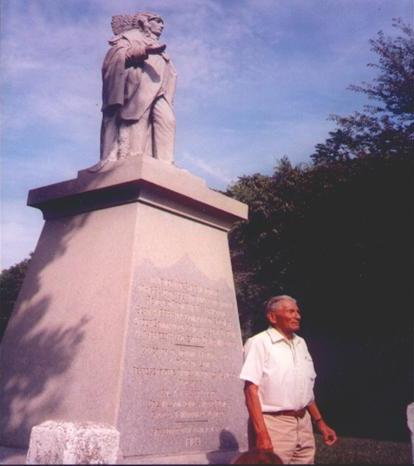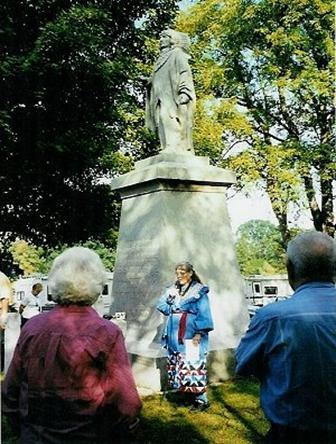|
by Shirley Willard, Fulton County Historian, Rochester, Indiana When I first saw the Menominee statue, I thought it was not likely to bear any real resemblance to Chief Menominee. The feathered war bonnet seemed more like that of the Plains Indians. But research revealed that the Smithsonian has similar headdresses labeled Potawatomi. When Paxico Wabaunsee visited us at Rochester in 1994, he and his brothers and sister were the honored Potawatomi family at the Trail of Courage Living History Festival. When we took him to catch his airplane from South Bend, we stopped and I took his picture beside the Menominee monument. When I got the film developed and printed, I was surprised to see that Wabaunsee’s profile matched that of the statue. So apparently the sculptor used a Potawatomi Indian as his model. Wabaunsee is a descendant of Chief Wabaunsee who, with his brother Black Partridge, helped save the John Kinzie family at the Fort Dearborn Massacre (Chicago) in 1812. 
Plymouth, Indiana - Chief Menominee statue. GPS N-4117714 W-8621714. James Paxico “Packie” Wabaunsee, descendant of Chief Wabaunsee, stands beside the Chief Menominee monument in September 1994. Paxico was a cousin to Bill Wamego and when he saw in the Topeka, Kansas, newspaper that Wamego was with the Trail of Death Commemorative Caravan coming from Indiana to Kansas in Sept. 1993, he drove down to the St. Philippine Duchesne Memorial Park (former St. Mary’s Mission at Sugar Creek) to meet them. But it was a dark and rainy night and he made a wrong turn and found himself in the flooded Sugar Creek on a road a couple of miles south of the park. At age 77, he could not swim and was afraid there might be snakes in the water, so he climbed up on his pick-up truck and prayed for rescue. He fired his gun 4 times, and then wondered if the distress signal is 3 times. There were no houses near and no one to hear him. The water got higher and the night got colder. Then he saw lights coming across the water - it looked like a bunch of boats. It was the caravan, led by Bill and Shirley Willard in their truck pulling a 5th wheel camper, followed by Eric and Susan Campbell in a motorhome, Bob and Ginger Pearl in a car, Jim and Eileen Pearl in a motorhome, George Godfrey in a pick-up truck and about 20 other cars. Willard had made a wrong turn too and led the caravan right down the same flooded road where Wabaunsee was stranded! This is the way Shirley tells it: When we arrived at Osawatomie for the banquet with the Osawatomie Historical Society, they hustled me to the telephone and I found out my mother had died that afternoon in the Rochester Nursing Home. Bill and I decided to stay with the caravan for the night and go back home the next day. Father Robert Pool gave us directions to the St Philippine Duchesne memorial park or shrine, where we all planned to camp for the night. He rode with Tom Hamilton and went ahead. Bill and I were leading the caravan but Bill turned too soon and got on the wrong road. He even stopped at a farm house to ask directions. Usually the other caravan members would tease us if we made a wrong turn but no one said a word. It was dark and rainy so I guess they did not know the roads either or were all tired and just wanted to get there. Finally we came to a sign that said “Shrine 5 miles.” So we thought “Good!” and turned that way. But that road had large patches of water across it and after going through water several times, I said, “Bill we shouldn’t be here. We can’t even see the road.” Then we saw up ahead that the road was completely flooded with deep water and a pick-up truck in the flood and a man standing on it waving his arms. We stopped and Eric Campbell and George Godfrey took off their shoes and waded in the water to rescue the man. It was Paxico Wabaunsee. When I heard the name Wabaunsee, I was scared. In the 1883 Fulton County Historical Atlas is a story about Chief Wabaunsee - that he had two wives and they were fussing so he told one to lie down on the ground and gave a tomahawk to the other and told her to kill her, which she did. I was afraid that his descendant would be mean like that. But Paxico was one of the gentlest men I ever met. He said he had not seen his cousin Bill Wamego since they were kids in 1929. I called Tom Hamilton on his CB radio and he answered from the Shrine. He told us to go to a nearby town, Parker, Kansas, where he and Father Pool would meet us and lead us to the Shrine to camp for the night. All of the cars and trucks turned around, which was no easy feat on that flooded narrow road because the ditch beside it was full of water and so were the fields. Our rig was too long and could not be turned around so Bill had to back it all the way out to the corner. He followed Eric’s tail lights and did not have to stop once to straighten it out. It was over a mile. We felt that was the rescue was a miracle! And Bill’s backing the truck and camper straight for over a mile was almost a miracle. The next morning we had Mass at the Shrine, with Father Pool officiating. Then I saw Bill crying. I went to his side and asked him what was the matter. Jim Pearl told us that he could not sleep the night before and that finally it came to him that the rescue was my mother’s first miracle when she got to Heaven. Father Pool said it was not a miracle but only the natural result of us not following his directions. He gave me a necklace with a white stone (opal) in which you could see a face. I never knew if the face was my mother or St. Philippine or an Indian woman. The next day the newspapers had pictures and a story about the rescue, emphasizing that the cousins, Wamego and Wabaunsee, had not seen each since they were 11 years old. But Bill and I headed back home to Indiana to arrange the funeral for my mother. I pondered these things all the way home and ever since, but I still do not know what to believe. A miracle? Bill Wamego died the day after Christmas in 1993. Bill and I drove to his funeral at Tulsa, Oklahoma. When we left the church to follow the line of cars to go to the cemetery, Paxico Wabaunsee and George Godfrey rode in our car with us. Forever etched in my memory is the sight of Paxico standing at the head of Wamego’s grave, holding the tobacco for the mourners to take a pinch of and sprinkle on the casket. Paxico was reciting Bible verses and never seemed to run out of them. Bill Wamego Jr. placed his father’s favorite clothes, including his hat, shirt, pants and boots, on the casket to be buried with him. The next summer I called Packie several times and begged him to come to the Trail of Courage. He wanted very much to come, and even though he had surgery and was restricted by his doctor as to travel, he flew out from Seattle, Washington, to the South Bend, Indiana, airport, where Bill and I picked him up. He stayed with us in our home for a week. I remember how contented he looked as he sat on a chair by the Singing Drum during the Indian dances at the Trail of Courage, smoking his pipe. While at our house, I interviewed him for a story which I wrote for the Rochester Sentinel. When it was time to leave, we started early enough to stop and show him the Chief Menominee monument. But we arrived at the airport with just a few minutes to spare so I stayed in the car with our grandkids and Bill got a wheelchair and rushed Packie in to the plane. Bill said they let him take Packie right unto the plane and when he said good-bye, Packie kissed him. We were both in tears as we drove home. Packie died that Thanksgiving, 1994. 
Plymouth, Indiana - Chief Menominee statue. GPS N-4117714 W-8621714. Pictured above: Chief Menominee statue with Shirley Willard, president of Fulton County Historical Society, speaking to 1998 Trail of Death Commemorative Caravan. (Photo by Gerald Wesaw, Bangor, Michigan, member of Pokagon Band Potawatomi.) |
| < Previous | Home | Next > |